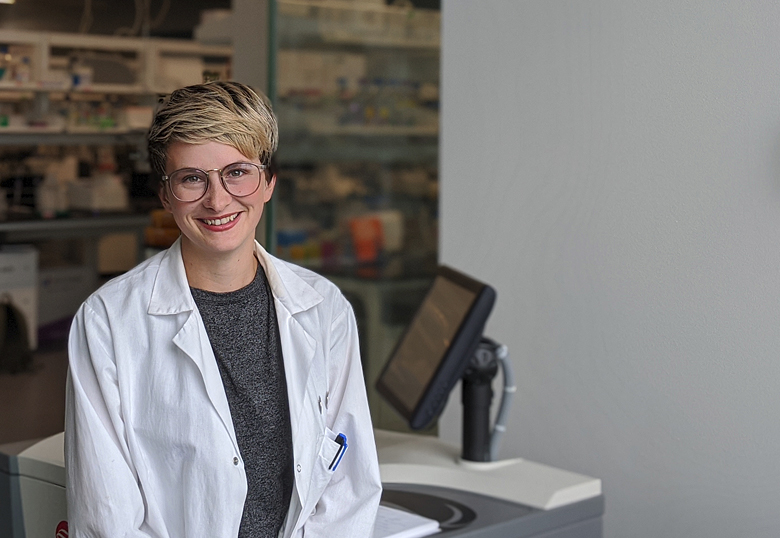In a recently published article in ACS Nano, a high-impact nanoscience and nanotechnology journal, University of Lethbridge master’s student Amy Henrickson (BSc ’17) and her collaborators at the University of British Columbia have devised a better way of measuring drug loading in lipid nanoparticle formulations (LNPs) using analytical ultracentrifugation (AUC).

These formulations are typically used in gene therapies and, more recently, in the development of some COVID vaccines. Lipid nanoparticles are very small and can be thought of as a capsule for delivering a treatment. Lipids occur naturally in the body in the form of fats, hormones and certain vitamins. In the case of the COVID vaccines, lipid nanoparticles are loaded with RNA that instructs the human body to recognize the spike proteins on the SARS-CoV-2 virus and thus build immunity.
For the quality control of these formulations, researchers need an accurate way of determining the RNA loading state of LNP formulations, because only a narrow range of RNA loading leads to the desired biological effect and assures patient safety; empty or overloaded LNPs are ineffective and can increase the potential for allergic reactions.
“The new method we developed is able to tell us the ratio of RNA to lipid,” says Henrickson, who studies under biophysicist Dr. Borries Demeler, a Canada 150 Research Chair. “There are advantages and disadvantages to all techniques, but many other methods involve low resolution bulk observations that lack the necessary detail. This method is able to tell if any LNPs are empty and if everything’s properly loaded with the preparation.”
The method, developed over the past two years at the Canadian Center for Hydrodynamics at the U of L, uses multi-wavelength AUC to measure the spectral profile of nanoparticle preparations, quantifying the RNA contained in the LNP. They also use heavy water to measure densities of preparations, which is sensitive to the RNA load. The work was done in collaboration with Pieter Cullis’ group at UBC, where they are working on developing lipid nanoparticles for gene therapy.
“In her short time as a graduate student in the Department of Chemistry & Biochemistry, Amy has already amassed 10 publications, including first-author contributions like the ACS Nano publication,” says Demeler. “Amy is a star student who has helped our group make significant and high-impact progress in many important fields, contributing novel discoveries to gene therapy and vaccine development.”
The Canadian Center for Hydrodynamics has also received a grant from the Biomolecular Interaction Technologies Center organization, which is based in the United States. The grant is to develop viral vector characterization in adeno-associated viruses (AAVs) using AUC, which forms the basis of Henrickson’s PhD work.
AAVs, which are not known to cause disease, are small viruses that can be used for gene delivery in the treatment of a variety of human diseases. Preparations made with AAVs tend to exhibit a mixture of loaded and unloaded viral capsids (the protein shell of a virus).
“Many methods currently in use can’t differentiate between different components in a preparation,” says Henrickson. “I’m trying to use AUC to create two or three different methods that will all be able to characterize an AAV formulation and tell you if there’s any free DNA, empty AAVs, loaded or partially loaded AAVs, or aggregates in the preparation.”
